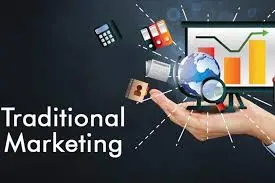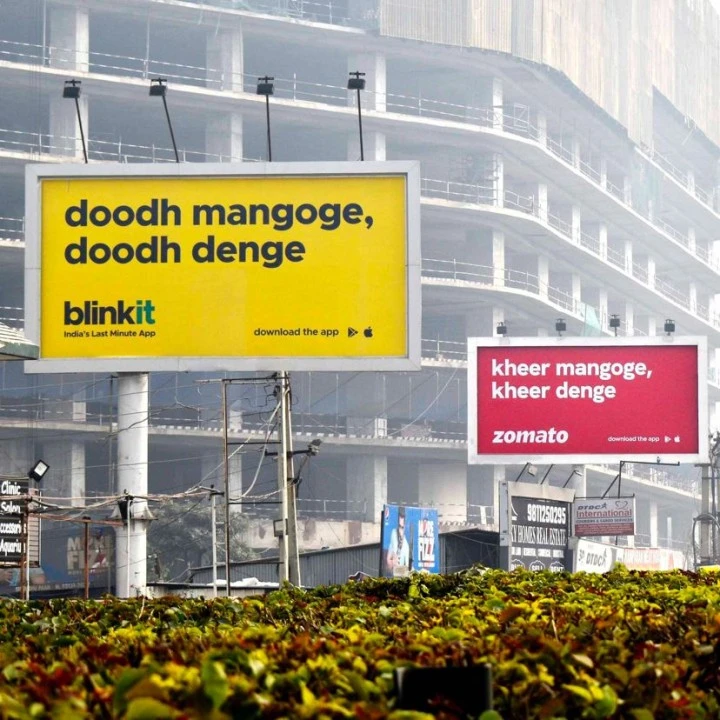
The difference between traditional marketing and digital marketing has become one of the biggest challenges for businesses in 2025. With so many options available, companies are scratching their heads trying to figure out which approach works best. Should they stick to the classic methods of traditional marketing, or shift towards the fast-growing world of digital marketing?
Table of Contents
Introduction
Your marketing might not be hitting the mark, and that could be why your business is stuck.Learning the difference between traditional marketing and digital marketing can provide clarity and direction
What is marketing?
Marketing is all about creating, talking about, giving, and trading things that people find valuable whether they’re customers, clients, partners, or just society in general.
There are mainly two types of marketing which can help you to grow your business
Traditional marketing
Traditional Marketing is the process of promoting products or services through offline methods, such as print advertisements (newspapers, magazines), television commercials, radio ads, direct mail, and billboards. It focuses on reaching customers through physical and mass media channels to build awareness and drive sales.
Digital marketing
Digital marketing is basically when businesses use online stuff like websites, social media, and email to tell people about what they sell and get their brand out there. It enables businesses to run targeted, measurable, and cost-effective campaigns compared to traditional methods.
Traditional Marketing – Definition & Overview

What is traditional marketing
Traditional marketing is the conventional way of reaching customers through offline channels like print, broadcast, and outdoor media. It emphasizes mass communication and brand visibility in the physical world
Major channels of traditional marketing
Print media

Print Media includes physical marketing materials such as newspapers, magazines, brochures, and flyers. Even in today’s digital era, print continues to hold strong value. It is especially effective for product launches, brand credibility, and reaching local audiences, making it one of the most trusted traditional marketing channels. Learning the difference between traditional marketing and digital marketing shows how print media provides tangibility, credibility, and longevity that digital methods may not.
- Print media offers tangibility, fostering higher engagement and recall.
- It’s often seen as more credible, boosting brand reputation.
- Print media can effectively target local demographics.
- Its longevity ensures repeated exposure.
- It generally feels less cluttered than digital ads, helping messages stand out.
Broadcast media

Advertisements in broadcast media are highly engaging and creative, utilizing a blend of compelling visuals and captivating audio to enhance audience comprehension and leave a lasting impact. Understanding the difference between traditional marketing and digital marketing highlights why broadcast media is still important for mass reach
- Radio is affordable and effective for local targeting
- Effective for product launches, seasonal sales, and events
- Example: A television commercial for a new car might show the car driving through scenic landscapes with upbeat music, demonstrating features and evoking adventure.
- Example: A radio ad for a local restaurant could use the sound of sizzling food and cheerful chatter to entice listeners, highlighting daily specials and a warm atmosphere.
Out of home marketing
OOH marketing refers to any form of advertising that reaches consumers outside their homes. It includes billboards, transit advertising, posters, street furniture, and place-based media. OOH ads are strategically positioned in high-traffic areas, making them effective for capturing attention and reinforcing brand messages.
Brands like Amul effectively demonstrate the difference between traditional marketing and digital marketing by showing long-term brand presence through hoardings.
- Provides high visibility in public spaces
- Targets consumers while commuting, shopping, or traveling
- Creates strong brand recall through repeated exposure
Works well for mass awareness campaigns
Direct mail marketing
Direct mail marketing includes physical promotional materials such as brochures, postcards, catalogs, and flyers that businesses send directly to potential or existing customers. The purpose is to create a personalized connection, promote offers, and encourage feedback or purchases.
Here again, the difference between traditional marketing and digital marketing is clear: traditional marketing relies on physical, tangible methods.
- Can be personalized, leading to higher engagement rates
- Provides a direct call to action, encouraging immediate responses
- This method aims to generate leads, drive sales, or build brand awareness through a tangible, personalized approach.
Case Study 1: Amul’s Billboard Campaign
How Amul uses witty hoardings for decades

Amul has used witty hoardings for decades, making the brand instantly recognizable. This case study shows the difference between traditional marketing and digital marketing in terms of long-term brand recall, customer trust, and cultural impact.
Amul is one of the biggest examples of OOH (Out-of-Home) advertising. I’m sure you’ve seen or at least heard of the famous Amul Girl. She has become the face of the brand and is loved for her witty, topical advertisements that often comment on current events and social issues. The Amul Girl campaign, first launched in 1966, is one of the longest-running and most successful advertising campaigns in India.
But what has all of this achieved?
- Amul is everywhere – seriously, you’ll find at least one of their products in every Indian home.
- Because of that, people really trust Amul.
- And let’s not forget their famous hoardings; they’re totally a part of India’s cool pop culture.
The Brand Recall Power of Outdoor Advertising
One of the biggest advantages of outdoor advertising is its ability to reach a wider audience. It includes hoardings, billboards, posters, and banners, all of which provide high visibility and impressive reach. understanding the difference between traditional marketing and digital marketing highlights why outdoor campaigns are still effective for mass awareness. Research shows that almost 55% of people remember the advertisements they saw on billboards, proving its strong recall power. Both global and Indian brands, such as Amul, have successfully leveraged outdoor campaigns to make their logos and taglines instantly recognizable.
ROI of Traditional Branding Campaigns
Amul’s traditional billboard campaigns, though challenging to measure ROI directly, demonstrate significant success. Their consistent, witty outdoor ads have fostered strong brand recall and trust, leading to increased sales, market share, and enhanced brand equity. This sustained presence has also built customer loyalty and generated organic word-of-mouth marketing. Ultimately, Amul’s growth, recognition, and consumer trust prove a substantial long-term ROI from their traditional marketing efforts. Analyzing the difference between traditional marketing and digital marketing demonstrates that traditional campaigns build brand equity in ways digital alone cannot always achieve.
Digital Marketing – Definition & Overview
What is Digital marketing in business
Digital marketing refers to all marketing efforts that use the internet and digital technologies to connect with current and potential customers. Unlike traditional marketing, it not only allows you to track your business performance but also helps you target specific people who are genuinely interested in your product or service, rather than reaching a mass audience blindly. The difference between traditional marketing and digital marketing is evident in its measurability and precision targeting.
Channels of digital marketing
Search engine optimization
Understanding the difference between traditional marketing and digital marketing helps explain why SEO is crucial for long-term online growth
If you want your business to appear at the top of Google search results, you need to understand SEO. Search Engine Optimization (SEO) helps you rank your website organically, without spending a single penny on ads. It not only drives traffic but also builds authority and trust for your brand.
- Technical SEO – Ensures your website is crawlable and indexable by search engine bots. It focuses on site speed, mobile-friendliness, secure connections (HTTPS), and overall technical performance.
- On-Page SEO – Refers to optimization within a webpage to improve its ranking. It includes heading structure, keyword placement, image optimization, internal and external linking, and content quality.
- Off-Page SEO – Covers all activities done outside your website to improve its ranking. This includes link building, social media marketing, influencer outreach, and brand mentions.
Content writing
Content writing includes creating blogs, articles, captions, social media posts, and much more. It is the process of researching trending or relevant topics and writing about them in an engaging and valuable way. High-quality content not only attracts and educates readers but also reduces bounce rate, improves SEO rankings, and helps businesses generate leads through blogs and other digital platforms. This highlights the difference between traditional marketing and digital marketing in engagement and measurable outcomes
Social media marketing (SMM)
It includes all activities that help promote your business on social media platforms through posts, reels, and stories. Social media usage has been growing by around 4.1% every year, making it one of the best strategies to create awareness about your product or service. The biggest advantage is that you can target specific groups of people based on their interests, demographics, and behavior, ensuring better engagement and higher ROI. Recognizing the difference between traditional marketing and digital marketing shows why SMM is cost-effective and highly engaging. Recognizing the difference between traditional marketing and digital marketing shows why SMM is cost-effective and highly engaging.
Affiliate marketing
Affiliate Marketing is the process of promoting other businesses’ products or services through special affiliate links. For every successful sale made through your link, you earn a commission. To get started, you first need to choose your niche and the platform where you’ll promote these products. The key is to build a loyal audience who trusts your recommendations and is willing to purchase through your affiliate link.
When learning about modern marketing strategies such as Affiliate Marketing, it also helps to understand the difference between traditional marketing and digital marketing, as both approaches impact how businesses reach and engage customers
Case Study 2: Zomato’s Instagram Marketing

Everyone knows how Zomato is famous for its funny and creative notifications. In the same way, they have used Instagram marketing very effectively. Their content is not limited to food but also includes memes, reels, and trending topics that attract a wider audience.
Instead of focusing only on product promotion, Zomato creates funny and relatable memes that connect with the youth. As a result, their meme marketing, witty captions, and creative visuals generate higher engagement in the form of likes, shares, and comments.
This approach shows the clear difference between traditional marketing and digital marketing, as Zomato builds two-way communication and a loyal community rather than just pushing advertisements.

Difference between traditional marketing and digital marketing
The following table highlights the key difference between traditional marketing and digital marketing, making it easier to understand both approaches
| Feature | Traditional Marketing | Digital Marketing |
| Definition | Traditional Marketing is the process of promoting products or services through offline methods | Digital marketing is basically when businesses use online stuff like websites, social media, and email to tell people about what they sell and get their brand out there |
| Channels | Print advertisements (newspapers, magazines), television commercials, radio ads, direct mail, and billboards. | Content writing, Direct marketing, Search engine optimization |
| Target Audience | Broad audience, not very specific | Highly targeted; you can filter by age, gender, interests, and location. |
| Reach | Limited reach, often regional or national. | Global reach with just an internet connection. |
| Tracking & Analytics | Hard to track exact ROI; relies on surveys and estimates. | Easy to track through tools like Google Analytics, insights, and dashboards. |
| Engagement | One-way communication; less interaction. | Two-way communication; customers can like, comment, and share. |
| ROI | Hard to measure; may take longer | Measurable in real-time; quicker results possible |
FAQ
What is the difference between traditional marketing and digital marketing?
So basically, traditional marketing includes all offline channels (as discussed above) and is mainly used for mass reach. However, it is often costly and considered outdated in today’s fast-paced world. On the other side, digital marketing has become the modern approach. It is cost-efficient, highly measurable, and allows businesses to reach a specific audience based on their interests and behavior. This clearly shows the difference between traditional marketing and digital marketing in today’s context.
Which is more effective in 2025: traditional marketing or digital marketing?
From my point of view, digital marketing is the best practice for any business that wants to promote its products or services effectively. It is especially helpful for companies that want to cut costs and reach only those audiences who are genuinely interested in their offerings. When we look at the difference between traditional marketing and digital marketing, it is clear that digital marketing provides better targeting, measurable results, and higher ROI, making it the smarter choice for modern businesses.
Can small businesses rely only on digital marketing?
Yes, actually every small business should consider digital marketing because it helps them get a quick boost. Since small businesses want to maintain their costs, they can start by targeting only a specific part of the audience online. However, the ideal strategy is to combine both traditional and digital marketing for maximum results. But if you are tight on budget, then focusing on digital marketing is the smarter choice. The difference between traditional marketing and digital marketing clearly shows why digital is more effective for small businesses today.
How do you measure ROI in traditional vs digital marketing?
Traditional marketing can be measured through surveys, customer feedback, and brand recall studies. On the other hand, digital marketing can be tracked more accurately with tools like Google Analytics, Facebook Insights, and conversion tracking, which provide real-time data on performance and ROI. This difference between traditional marketing and digital marketing makes digital the more measurable and transparent option
Can traditional and digital marketing work together?
Yes, this is the best practice and that’s why most big MNCs adopt it. Companies with sufficient budget usually invest in both traditional and digital marketing to maximize their results. For example, a TV advertisement can be used to create massive awareness about a product, while Meta (Facebook/Instagram) ads or Google Ads can be used to generate targeted leads. The difference between traditional marketing and digital marketing is that one builds broad visibility, while the other drives measurable conversions — together they create a powerful strategy.
Pingback: Top 10 good habits for students to become successful-Must Read